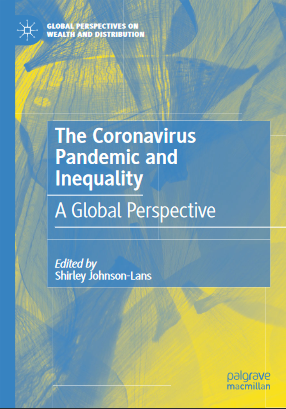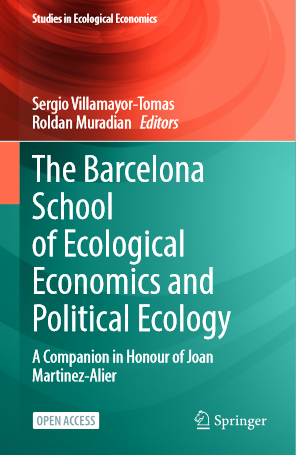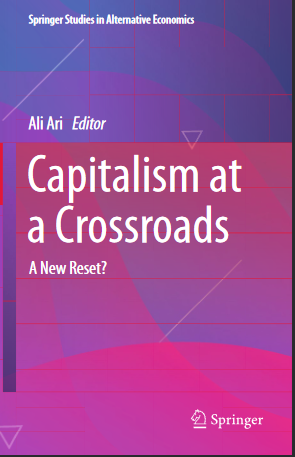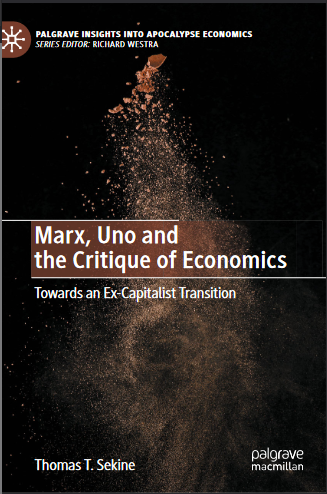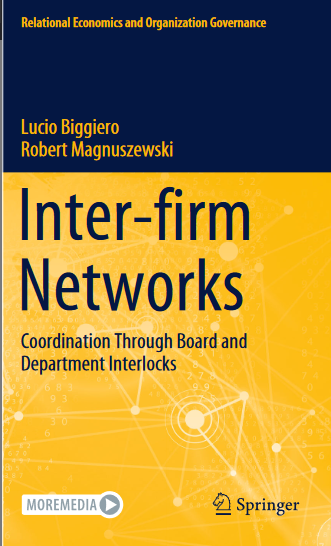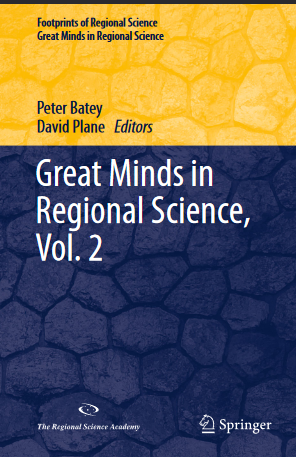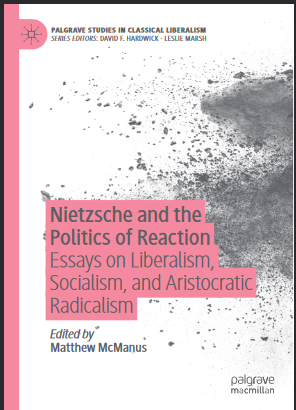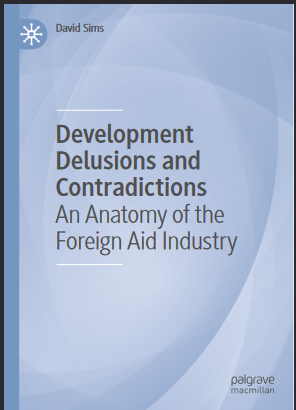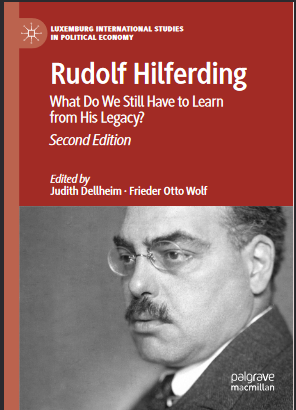موضوعات
آموزش و پرورش
ادبیات و زبان
پزشکی، دندانپزشکی و داروسازی
تاریخ و جغرافیا
داستان و رمان
دیگر
دین و فلسفه
روانشناسی
ریاضیات و آمار
سلامتی، تناسب اندام و رژیم غذایی
شیمی و پلیمر
علوم اجتماعی و حقوق
علوم زیستی و بیوتکنولوژی
فیزیک و نجوم
کامپیوتر و اینترنت
کتابهای کودکان و داستان
کسب و کار و اقتصاد
کشاورزی و دامپزشکی و غذا
معماری
مهندسی و فناوری
هنر و تئاتر
محصولات
The Coronavirus Pandemic and Inequality - Original PDF
نویسندگان: خلاصه: his book has been a long time in the making. It was first conceived in the summer of 2020 at which time few people expected a pandemic of the length we have experienced, dealing with a virus that is so efficient in morphing into ever more transmissible variants. Much of the world, including Europe, the United States, and Australia, now seems to have reached a point where COVID-19 is beginning to be regarded as endemic with occasional upticks, much like the annual influenza epidemics with which we have all learned to live. However, since we are not really out of the woods yet with respect to the COVID-19 pandemic, especially as vaccination rates in many parts of the world are well below where they need to be, this book can only be a provisional assessment of the effects and response to the coronavirus pandemic. It is an attempt to summarize and take stock of where many countries in the world stand as of October 2022The Barcelona School of Ecological Economics and Political Ecology - Original PDF
نویسندگان: خلاصه: Joan (Juan) Martinez-Alier has been a pioneer in ecological economics. In addition to being one of the founding editors of the journal Ecological Economics, he con- tributed enormously to its theoretical development, as well as to uncovering and explaining its foundations in the history of economic thought. As if that were not enough, he served as president of the International Society for Ecological Economics, as professor and mentor of many European students in this new field at the University of Barcelona and as a social activist for ecological justice all over the world. Back in the mid-1960s, I read something he had written that impressed me, and I wrote him about it. Later while attending a conference in Barcelona, I managed to meet him briefly. Our friendship grew at early conferences on ecological economics in Stockholm and Barcelona and in Costa Rica. On a trip to the USA, he visited me at Louisiana State University, and later, I managed to get him as a consultant at the World Bank for a month, although neither his efforts nor mine had much influence on that institution. I regret that the Atlantic Ocean prevented more frequent and closer contact between us. Nevertheless, collegial friendship with Joan has been a great personal benefit to me, as it has also been to many others. His many intellec- tual and moral contributions are a gift to all ecological economists, and to the world. Felicidades y gracias, Joan!Capitalism at a Crossroads A New Reset? - Original PDF
نویسندگان: خلاصه: Introduction Ali Ari Abstract Over the last three decades, the world economy has faced several complex and interrelated problems such as global climate change, food and energy scarcity, rising inequality, poverty, and more frequent and severe financial and economic crises. However, the capitalist system has been struggling to bring responses to those increasing problems and uncertainty. This has generated lively debates on the sustainability of the liberal capitalist economic system. Therefore, this book aims first to assess current problems of the world economy from a theoretical and empirical perspective, then to propose plausible answers from different points of view to restore the capitalist economic system. Keywords Capitalism · Sustainability · Growth · Climate change · Global warming · Agriculture · Energy · Inequality · Debt · Financial crises · Financialization · Poverty · Trade wars · COVID-19 · Political crises · Economic security · Artificial intelligence · Technological change · Great reset · Degrowth · Green deals · Solidarity economy · Balance of power · Smart citiesMarx, Uno and the Critique of Economics - Original PDF
نویسندگان: خلاصه: Several years ago a young American gentleman came to spend a summer in Tokyo, and during his stay there contacted me hoping to arrange an interview with me; to be centred on my Unoist approach to Marxian economics. While willing to cooperate with him in that project, I was not confident from the beginning that I would be able to produce a satisfac- tory result for him. For I am not the type of person who has ready-made answers to questions that are typically thrown at him/her on the spur of the moment. Nevertheless, we thoroughly enjoyed meeting with each other and got along very well in our personal exchange of views on the subject matter. When he was about to leave Tokyo, I asked him to write down on paper a series of questions that he would have liked to ask me, which would give me the chance to elaborate upon. I thus obtained a series of wonderfully worded and exquisitely phrased questions that would have given me only delight and pleasure to answer. I have revisited these questions over the years and have had time to consider them against the progress my life-long research on Uno’s approach to economics has made since then. I now have a fully extended, more mature version of what makes economics an “objective” knowledge. In both parts, but especially in the first, I made use of the delightful phrasing that my American friend originally employed in posing his apt questions to me. I am grateful for his allowing me to reproduce once again some of his superb style of language in this bookInter-firm Networks Coordination Through Board and Department Interlocks - Original PDF
نویسندگان: خلاصه: Firms do not interact only through prices, quantity or quality: rather they employ many other ways to coordinate their behavior. However, it is still rather unclear under which circumstances the mix of different ways is built, neither the relative relevance of each of them. What is sure is that one of such ways is through sharing a director between boards of related companies: this is the phenomenon named interlocking directorates or, more recently, board interlock (BINT), known since long, but still deserving a lot of attention. Actually, this is a form of coordination which occurs at a company’s highest level, because boards decide—or at least address to—the strategic behavior. There are indeed many reasons to share a director, reasons that do neither always nor intentionally deal with strategic issues. However, whatever they are, the effects of board interlock always impact, to a more or less extent, the sphere of strategies. Further, and more noteworthy, more or less intentionally and extensively, they imply some form of knowledge creation and sharing, espe- cially under its tacit form. In fact, what should actually be done when one sits in a board and how to perform this is not a task so precisely defined: its concrete execution depends primarily and essentially on the personal characteristics of each involved director and on various organization-specific circumstances. Hence, this is the conceptual perspective applied into this book: Board interlocks are inter-firm coordination forms that channel strategic knowledge, which is a resource particu- larly precious in innovation-based industries, and one becoming progressively more important also in all other industries. Due to these characteristics, the main research streams employed in this work are the four following: board interlocks, knowledge networks, inter-firm networks and Social Network Analysis (hereafter, SNA) as the main methodological approach.Handbook of Hope Theory, Measures, & Applications - PDF
نویسندگان: خلاصه: This Handbook of Hope simply would not have happened without a small army of graduate students who, over the past decade, have come into my office one by one and suggested yetanother angle from which we could view hope. In that sense, what has come to be called hope theory has been like a gemstone that, when held to the light, sends shimmers of ideas about yet other possible implications or experiments. I have produced previous theories about reactions to personal feedback, uniqueness seeking, excuse making, and reality negotiation, hue none of chose have continued co produce the sufficiently intriguing questions to get me revved up for yet another experiment. Hope theory has been a great energizer at a time in my life when I have needed it. For the past seven years I have had a severe, unrelenting, and undiagnosed chest pain that is with me from my fim waking moments to the time th.at I slip off into sleep. Although I have been taking powerful pain killers, I think that none of those pills matches the positive effects of my getting lost in theory and research and work- ing with my students. At age 55 (by the time this book is published), I still enjoy the theory and bench science to the same degree that I did as a brand new 27-year- old assistant professor here at Kansas. And so, I have much for which to be th:.ink- ful.Great Minds in Regional Science, Vol. 2 - Original PDF
نویسندگان: خلاصه: This second volume in the book series, Great Minds in Regional Science, continues telling the story, begun in the first volume, of the intellectual history of regional science. The perspective provided is through the lens of the contributions made by individual scholars influential to the multidisciplinary field’s establishment and development. The Great Minds series is a project of The Regional Science Academy (TRSA). The contributing authors are, themselves, leading scholars in the field, many having already been elected to membership in the Academy and as Fellows of the Regional Science Association International. Each chapter gives the author’s contemporaneous view on the scientific relevance of a great thinker. The sets of Great Minds featured in the specific volumes of the series have been chosen to include a blend of well- known figures and others meriting wider recognition for having advanced—in some significant way—the field’s pedagogy and institutionalization. The books in the series, Great Minds in Regional Science, together with those in The Voice of Regional Science (general and strategic reflections on new topics in regional science) currently comprise the Regional Science Academy’s meta-series, Footprints of Regional Science, under the general editorship of Kingsley Haynes, Karima Kourtit, and Peter Nijkamp. Since early 2016, highly successful series of sessions sponsored by the Academy have been held at locations throughout the world and featuring mini-lectures on topics germane to the two constituent book series. The chapters published in this volume of Great Minds in Regional Science derive from these earlier presentationsNietzsche and the Politics of Reaction Essays on Liberalism, Socialism, and Aristocratic Radicalism - Original PDF
نویسندگان: خلاصه: Introduction Matt McManus Liberal institutions cease to be liberal as soon as they are attained: later on, there are no worse and no more thorough injurers of freedom than liberal institutions. Their effects are known well enough: they undermine the will to power; they level mountain and valley, and call that morality; they make men small, cowardly, and hedonistic — every time it is the herd animal that triumphs with them. Liberalism: in other words, herd- animalization. Friedrich Nietzsche, TwiligDevelopment Delusions and Contradictions An Anatomy of the Foreign Aid Industry - Original PDF
نویسندگان: خلاصه: xix Around 1700 almost everyone on earth was poor or destitute, and Thomas Hobbes’ phrase about life as “poor, nasty, brutish and short” certainly hit the mark. Perhaps only one-tenth of the world’s population was living what could be considered anywhere near comfortable lives. At least, this is what most economic historians will tell you. Jumping ahead 250 years, one could definitely say two completely dif- ferent worlds had emerged—a prosperous West and a definitely lagging Rest. The reasons for this ascendency of the West were due to processes and factors that, even today, are not well understood, but this huge West– Rest economic divide led to the realization that this gap was one of the great issues of the times, one that needed to be addressed as part of any new world order. Thus, by 1950 it could be said that the Development Era began. Some 70 years later, after untold machinations and lots and lots of money, the West is still very much at it. Western nations and institutions constructed increasingly sophisticated systems to redress this divide, based originally on the idea that transposed expertise and capital was what was needed to help nations build modern economies, to prosper, and eventually to be self-sustaining. Not only would these ‘emerging’ nations become partners in global prosperity; they would become great consumers as well and, through the miracles of free trade, economies of scale and comparative advantage, the West as well as the Rest would benefit. Yet what sounded so clear and noble back at the start of the Development Era, and what has remained, at least ostensibly, the philosophical bedrock of helping poor nations, has had to face a very rocky road, to say the leasRudolf Hilferding What Do We Still Have to Learn from His Legacy? - Original PDF
نویسندگان: خلاصه: Editors and authors are, of course, grateful for the interest of our readers that has made it possible to realise a second edition now. We have made use of this happy occasion to correct mistakes we had overlooked in the first edition, to actualise the texts wherever needed, and to add four texts: one by Michael R. Krätke on the still unpublished notes of Hilferding’s last manuscript which had been published post-humously (discussed as such by F. O. Wolf), and another one, also by Krätke, on Hilferding’s cor- respondence; plus a presentation of Krzywicki, the Polish ‘equivalent’ to Hilferding, by Toporowski, as well as a contribution by the editors open- ing a perspective on Varga. We hope to fuel the incipient debate on Hilferding by providing access to these materials—which are not merely of biographical relevancy. We also have added a contribution on Eugen Varga, leading on to the next collection of texts planned in this series. All authors have had the occasion to revise their texts according to the need they could see for this. Accordingly, the new edition will serve as a use- ful tool for further developing the debate on Hilferding, after it had been unblocked from political fetters resulting from older political antagonisms. We have become aware that there is an important and specific debate on Hilferding in Japan. Minoru Kurata and Masaaki Kurotaki should at least be mentioned here. Unfortunately, we have not been able to find a Japanese author for presenting this debate authentically, for which we only Preface to the second edition xviii PREFACE TO THE SECOND EDITION have passing references in the volume. This remains an open challenge for further research and debate.1 In finishing this volume, while the terrible ‘military operations’ gener- ated especially by Putin and his narrow power circle are unfolding, we want to underline the deep internationalist character of our work aiming at strengthening critical thinking and emancipatory-solidarityآیا کتاب مورد نظر هنوز بر روی سایت قرار نگرفته است؟ جای نگرانی نیست! کافی است بر روی گزینه سفارش کتاب کلیک کرده و درخواست خود را ثبت کنید. در کمتر از چند ساعت کتاب شما را آماده خواهیم کرد.
